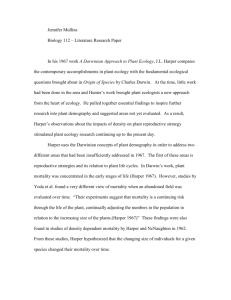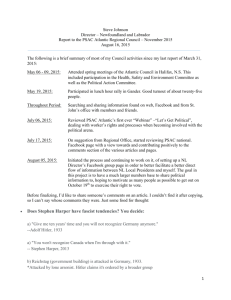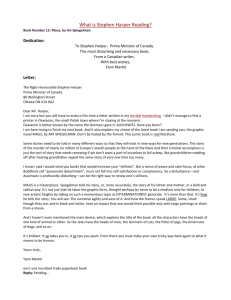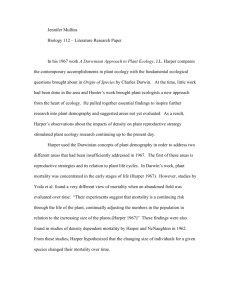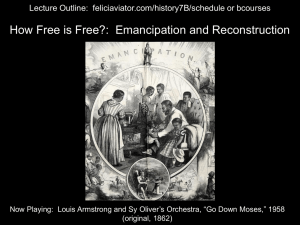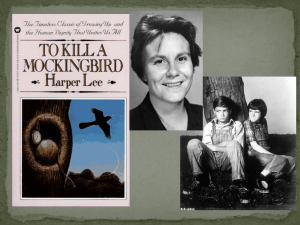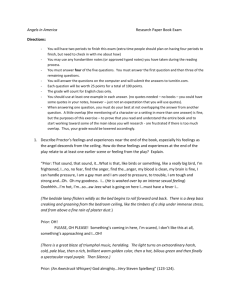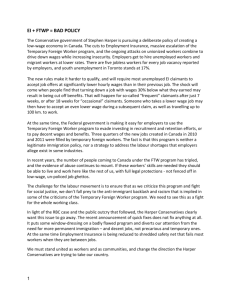In his 1967 work A Darwinian Approach to Plant Ecology, J
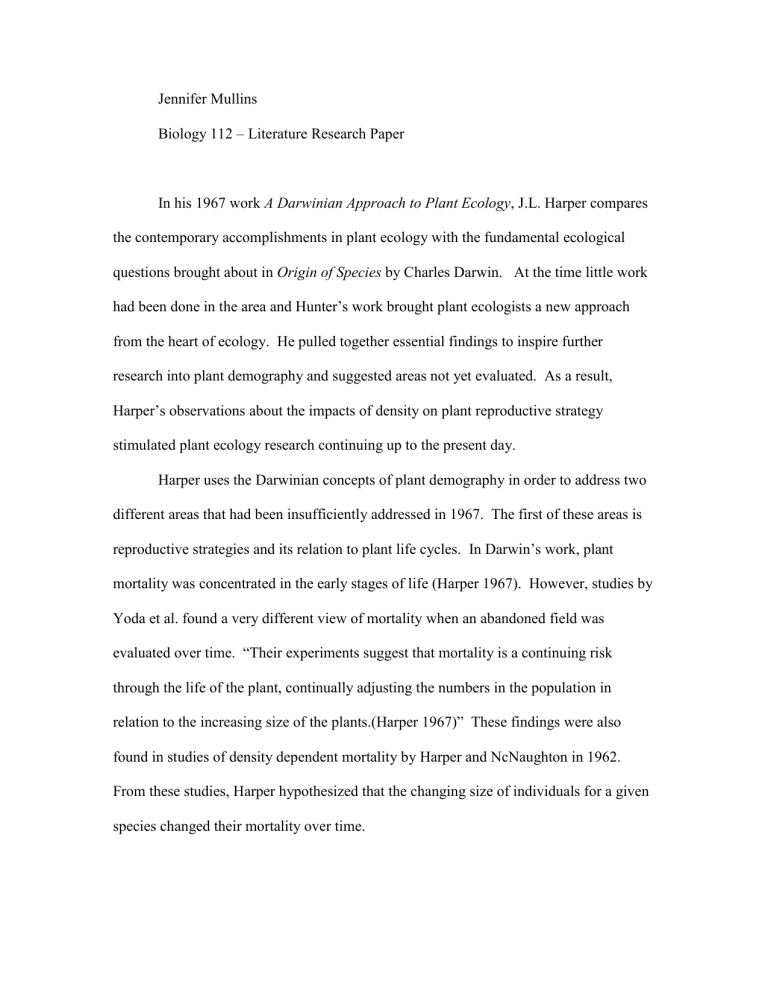
Jennifer Mullins
Biology 112 – Literature Research Paper
In his 1967 work A Darwinian Approach to Plant Ecology , J.L. Harper compares the contemporary accomplishments in plant ecology with the fundamental ecological questions brought about in Origin of Species by Charles Darwin. At the time little work had been done in the area and Hunter’s work brought plant ecologists a new approach from the heart of ecology. He pulled together essential findings to inspire further research into plant demography and suggested areas not yet evaluated. As a result,
Harper’s observations about the impacts of density on plant reproductive strategy stimulated plant ecology research continuing up to the present day.
Harper uses the Darwinian concepts of plant demography in order to address two different areas that had been insufficiently addressed in 1967. The first of these areas is reproductive strategies and its relation to plant life cycles. In Darwin’s work, plant mortality was concentrated in the early stages of life (Harper 1967). However, studies by
Yoda et al. found a very different view of mortality when an abandoned field was evaluated over time. “Their experiments suggest that mortality is a continuing risk through the life of the plant, continually adjusting the numbers in the population in relation to the increasing size of the plants.(Harper 1967)” These findings were also found in studies of density dependent mortality by Harper and NcNaughton in 1962.
From these studies, Harper hypothesized that the changing size of individuals for a given species changed their mortality over time.
However, reproductive strategies in higher plants were relatively untouched by ecologists at the time of Harper’s paper. He cites Cole’s paper from 1954 which was further studied by Lewontin in 1965 as some of the initial work on the area. Cole compared the changes in life cycles due to population growth in annuals and biennials.
As he tried to understand how each should grow in order to maintain similar populations he developed theories concerning the nature of r-K selection theory. Harper put the importance of this research in terms of Darwin’s discussion of struggle, which is at the core of species behavior. He also challenged ecologist to consider these strategies with regard to patches as well as individuals because both are influenced as seen in initial studies by Kira, Ogawa, and Sagazaki and Koyama and Kira.
From this basic analysis of reproductive strategy dynamics, Harper moved on to discuss how the concept of coexistence can be considered with Darwinian thinking. The idea of a winner and a loser among species competing for resources is essential to
Darwinian fitness; however the continued existence of diversity means that losers do not die off completely (Harper 1967). To this effect several ecologists like Hutchinson,
Gause, and Gleason had studied the dynamics between competing species. These studies presented equations and models yet to be brought into the norm of plant ecology discussion.
In his conclusion, Harper eludes to the huge potential that the concepts he mentioned may contain. “It is impossible in the time of one lecture to do justice to the range of ecological thought and the stimulus to modern experimental ecology to be found in just two chapters of the Origin of Species .” He suggests that the guiding questions for the next hundred years of ecology will be found in one of the most fundamental
ecological documents. Harper made the connections between various related studies where little communication had existed. The concepts became more in-depth and understood as a result of his paper.
According to Paul A. Keddy, “Harper does not address plant community ecology, but rather advocates the study of plant population (Keddy 2005).” There was little to no communication between plant ecology researchers before Harper’s paper. This is what made Harper’s paper so important for the next 25 years. His hypotheses were based on previously published studies, the general questions and conclusions he drew from their culminated information made the paper a catalyst for further research.
The relationship between mortality and density is the most important
“contradiction” between Darwin and the emerging concepts of plant ecology when
Harper wrote his paper. After Harper’s paper, more plant ecologists reaffirmed that mortality can vary between species and in time. Many studied the dynamics of the
Reproductive Effort (RE) of species which evaluated how much of an individual’s resource intake went into creating the next generation. It was from this starting point that research progressed.
J. P. Barkham in 1980 used the mathematic calculations gathered in Harper’s paper as well as environmental conditions in Brigsteer Wood to add evidence to density dependent mortality in plant species. He found that “control of the size of the adult population may be primarily through the plastic response of clonal growth to density
(Barkham 1980).” This and research by Stephen Waite in 1984 looked at the issues of mortality in a broad sense as well as on an individual level. Waite found that “individual rosette mortality was related to plant age and size” and that 2 different communities of
Plantago coronopus in Sussex were density dependent. A main proponent to all of these studies was that limited resource availability creates varied levels of densities that a habitat could maintain. By being aware of these limitations, species had different life cycles in order to survive.
Harper’s discussion of various reproductive strategies based on resources was also found to influence the life cycles of coexisting species. In 1979, Paul Garth Harrison verified the differences between r and K selection in coexisting seagrass species. He tested the conditions in which Harper thought these types of species would thrive based on their life histories. The r-strategist was found in upper intertidal regions because it could persist with large fluctuations in temperature and salinity. The K-strategist works well in areas where there is less variation. The natural conditions have varying impacts on the 2 species because they do not use the same amount resources for reproduction.
The r-strategists can use up to 25% of its resources for flowering while the k-strategist puts the majority of its resources into biomass accumulation. This means that an r species will create more offspring over a shorter period of time which will make it more likely to survive fluctuations (Harrison 1979). It is also possible for both species to coexist in the mid range of the inter-tidal area because disturbances are not limiting to the kspecies and varied resource needs.
Harrison questioned if just the existence of resources was necessary. He concluded with unanswered questions about the necessity of specific nutrients like
Nitrogen and Phosphorus and whether nutrients allocated to reproduction were mutually exclusive to those put towards growth. He was not the only one to questions these issues.
In 1986, Samson and Werk compiled most of the research up to that point on RE to create
models to evaluate how density and RA were related. They hypothesized that more than density and resource availability, the guiding determinations of RE were “(1) size at first reproduction, (2) absolute reproductive investment at first reproduction, and (3) rate of incremental allocation to reproduction with incremental increases in plant size(Samson and Werk 1986).” The size of individuals is one of the concepts suggested in Harper’s paper; it is supported with graphical analysis and many examples in Samson and Werk’s paper.
The concepts of resource allocation to reproduction as seen in the papers mentioned above as well as the original hypothesis suggested by Harper led to the study of how competition can change the reproductive strategies of plants. Harper’s paper discussed his own work on differences between monoculture stands and mixed stands. In
1992, Wiener and Thomas used the above relationships to assess allometry when competition is and is not present. By looking at biomass and leaf area, they found linear relationships among the different aspects of vegetative growth when species were grown in isolation. However, when competition was introduced, patterns were irregular and growth in some areas was discontinued all together. This suggests that Samson and
Werk’s assumptions of size importance are more complicated in ways that Harrison mentioned in his discussion of resource availability.
In 1998, Schwinning and Wiener looked at the components of size differences among species in an attempt to clarify what makes the difference in plant survival based on what makes size different. They questioned the use of generalizations when describing how “resources” influence plant growth. As a result, they found variation in the importance and influence of different resources such as mineral content in soil and
light (Schwinning and Wiener 1998). This is helps answer Harrison’s questions and provides more depth to Harper and others earlier work that showed the importance of resources.
Most recently, research has continued to focus on the dynamics of plant reproductive strategy. Self-thinning as a result of resource competition is still being reviewed and debated. There is also research taking place on the effects of predation and parasitism on reproductive strategy. All of the current research is adding to the evidence to support previous papers as well as fill in the gaps in relationships among resources, individuals and communities. But I think that research could discuss more of the genetics surrounding reproductive strategy. Plants have less genetic material compared to animals so the research would be somewhat easier. However, the plant responses to environmental conditions are so varied and specific to the resource that the genetics could be very complicated. Researching this area creates even more questions and answers about how plants survive.
In time Harper’s original hypothesis was explored, altered, and used as a spring board for over 25 years of research into reproductive strategy among plants. His initial hypothesis on density became a matter of individual plant size. This was explored in terms of biomass as well as on an individual and community basis which was the type of research that Harper was hoping would be created. More recently the studies have looked at exactly what makes size variation, another principal based in the Darwinian thought that Harper encouraged ecologists to look into. It could be said that Harper’s hopes for the field have come true and research will continue as long as questions can be pulled from Origin of Species just as Harper did in 1967.
Works Cited
Barkham. J. P. 1980. Population Dynamic of the Wild Daffodil (Narcissus
Pseudonarcissus): I. Clonal Growth, Seed Reproduction, Mortality, and the Effect of Density. Journal of Ecology . 68: 607-633.
Harper, J.L. (1967) A Darwinian Approach to Plant Ecology. Journal of Ecology . 55:
247-270.
Harrison, P. G. (1979) Reproductive Strategies in inter-tidal populations of 2 cooccurring seagrasses (zostera spp).
2638.
Canadian Journal of Botany . 57 (23): 2635-
Keddy, P. A. 2005. Milestones in ecological thought – a cannon for plant ecology.
Journal of Vegetation Science . 16 (2): 145-150.
Samson, D. and Werk, K. (1986) Size-Dependent Effects in the Analysis of Reproductive
Effort in Plants. The American Naturalist . 127 (5): 667-680.
Schwinning, S. and Weiner, J. (1998) Mechanisms determining the degree of size asymmetry in competition among plants. Oecologia . 113: 447-455.
Thomas, S. C. and Weiner, J. (1992) Competition and Allometry in Three Species of
Annual Plants. Ecology . 73 (2): 648-656.
Waite, S. (1984) Changes in the Demography of Plantago Coronopus at Two Coastal
Sites. Journal of Ecology . 72: 809-826

